When Splatoon first rolled into town, I was captivated by its fresh gameplay, colorful aesthetic and compelling world. Unfortunately, the scourge known as “bad college internet” stopped me from ascending far on the multiplayer ladder, and I missed quite a bit of action — which is why I’m excited for Splatoon 2, as another chance to ink the battlefield lies only a few months from now. And having played a couple dozen matches in the Global Testfire, my anticipation has only grown.
The little things
At a glance, playing Splatoon 2 was just like the first entry — you control an intrepid squid kid known as an Inkling alongside three squadmates (squidmates?) as you attempt to cover more of the battlefield with your ink than the opposing team. The core gameplay has remained almost exactly intact, but there are a few subtle differences worth pointing out.
First, the UI in general has been tweaked and enhanced significantly. You can now see the weapons of your teammates and opponents at the top of the screen, as well as whether somebody’s dropped out due to a disconnect. Your ink meter also shows a little notch letting you know how much minimum ink you need to use your sub-weapons at any given time, taking out the guesswork on that front. Add in the fact that everything looks smoother and even more stylized and you have a slick looking game.

One of the big features of the first game was using the GamePad to survey the battlefield and also check squidmates’ positions, jumping to where they are if need be. Without that tool, the same functions now require pulling up the map with the X button and using your reticle to select a teammates’ position. It’s a bit less clunky than it sounds at first glance, but I can’t tell you how many times I accidentally pulled up the map when I meant to jump – muscle memory from the first game (and Breath of the Wild) proved a nemesis for a while.
The game’s presentation seems very much in line with the first, and all the better for it. I really dug the remixes of the first game’s soundtrack, particularly the matchmaking song, and the aesthetic is still vibrant and full of a ’90s J-pop culture personality. The new hairstyles felt like an even bigger breath of fresh air, and I can’t wait to see what kind of customization options come in the future.
Broad strokes
The Testfire’s selection of weapons and stages was/is limited, but enough to provide decent variety. Nintendo did an excellent job striking a chord between familiarity and new, offering both quite a few old weapons alongside a new one and several changes in loadouts.

For starters, three of the weapons — Splattershot, Splat Roller and Splat Charger — make their return. The Splattershot is your standard shooter, offering a balance of range, power, and rate of fire. It was probably the one that saw the most use from me. The Splat Roller is a bulldozer that can mow down enemies and also flick paint at them if need be. It felt a bit weightier than I remembered from the first game, but also a bit longer reaching to compensate. And the Splat Charger offers immense range and precision for a decent startup time and not much width. It was my least favorite kind of weapon in the original Splatoon, and it didn’t feel like much had been tweaked here. The sub-weapons for all these types were also returning favorites — Burst Bombs, Suction Bombs, and Splat Bombs, respectively.
The new squid on the block is the Splat Dualies, two pistols that fire incredibly fast at a fairly short range. What made them very interesting was the ability to roll with the B button while firing, allowing a quick dodge and a quick spurt of fire. They seemed more difficult to master than the other weapons, and also offer greater reward if proficient enough. While I wasn’t fantastic with them, I could see a great amount of potential in how they handled, and I went up against some truly accurate gunslingers. It also offered a new sub-weapon in the Curling Bomb, which felt similar to the Seekers from the original — clearing a path forward before exploding colorfully.
The nicest thing about the Testfire was that all of the weapons had all new specials, each of which felt inventive and unique. The Splattershot gave Tenta Missiles, lock-on rocket launchers that could strike from across the entire field — easy to use, but also fairly easy to dodge. Splat Roller offered the Splashdown, a close range circular blast modeled after celebrations on the gridiron. Splat Charger’s special was the Sting Ray, a long, hard hitting beam that could be controlled — kind of like the Killer Wail, except movable, longer lasting, and not as expansive or powerful. And finally, Splat Dualies allow one to use the powerful Inkjet, which offers a paint-powered jetpack alongside a hefty bazooka. While a bit sluggish and difficult to aim, it can provide for some huge opportunities in the right hands.
The stages played on were simple, yet different enough to provide a slight shift in strategy. The Reef features a bridge in the middle alongside several ramps and corners, making the map chaotic and frantic in style. Meanwhile Musselforge Fitness provides even steeper ramps and taller ledges, making it difficult to break deep into enemy territory – most fights here were held in the center, brutal and inky. Both were great fun to play on, and felt just different enough to provide a slightly different experience.
Stray observations
While I had great fun with the Testfire, there are a couple issues worth addressing — namely, disconnects. Now it is, of course, the nature of public betas that there are technical issues, and I have no doubt that they’ll be improved by the time the game releases, but it still must be noted. I was only kicked once from a game unceremoniously, but I saw at least one person drop out every three or four matches or so, which is somewhat alarming. There were also several instances of lag — opponents or allies dying a second or two after they should’ve, shots not registering even though they hit, and so on. I sincerely hope Nintendo focuses on these issues and irons out all the bugs they can before release.
Besides those slight hiccups, however, the events have been a blast. The core gameplay of Splatoon has remained almost entirely the same, and that’s perfectly fine — it still feels as unique and interesting as it did a couple years ago. If you disliked the first for any reason, you probably won’t find much reason to pick this one up — but if you found any enjoyment in the first game’s multiplayer, you’ll likely have a great time here.
If there’s anything I’ve taken from the Testfire, it’s that the range of crazy happenings has only increased. A fellow contributor to Nintendo Wire told me how he ended up in an aerial Inkjet match against an opposing Splat Dualies user, firing shots off as they attempted to avoid becoming splatted. There have been times where I fire Tenta Missles at a foe just as they do the same to me. Matches won by just a hair of a percentage point, just because one side remembered to spray a car..
Splatoon is back, friends, and fresher than ever.
Leave a Comment

